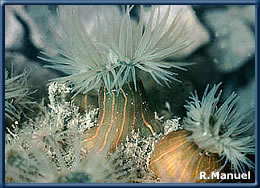

Phyllorhiza punctata

Cassiopea andromeda

Pennaria disticha

Carijoa riisei

Diadumene lineata
Diadumene lineata
 Orange-striped
sea anemone
Orange-striped
sea anemone
Phylum Cnidaria
Class Anthozoa
Order Actinaria
Family Diadumenidae
Description
Small anemone with tentacular crown to 3.5 cm in diameter, 3 cm in height;
column cylindrical, smooth green-gray or brown, with or without vertical
orange or white stripes. Tentacles 50 to 100 in number, slender tapering,
fully retractile, usually transparent, sometimes gray or light green flecked
with white.
Habitat
On solid substrates (undersides of stones or shells, on pilings or floating
docks) in intertidal pools or shallow-water protected areas such as harbors
and embayments, often associated with mussels or oysters. May occur in
brackish water.
Distribution
Hawaiian Islands
Known only from Kaneohe Bay, Oahu
Native Range
Western Pacific (Japan, China, and Hong Kong)
Present Distribution
Western Pacific, Indonesia, New Zealand, Hawaiian Islands, Pacific Coast
of North America, North Atlantic
Mechanism of Introduction
Unintentional, as fouling on ships' hulls or with commercial oysters
Impact
Fouling organism. Ecological impact unstudied, but presumed minimal.
Ecology
Feeding
The anemone is a carnivore, using the stinging cells in its tentacles
to capture plankton which drifts by in the currents. The feeding tentacles
carry the prey to the mouth region where it is ingested whole.
Reproduction
Anemones can reproduce asexually by simply splitting themselves in half
(longitudinal fission). Sexual reproduction is most likely achieved through
the release of gametes by both sexes followed by external fertilization
and embryonic development.
Remarks
A population of this distinctive orange-striped sea anemone was discovered
on a piling on the south shore of Kaneohe Bay on February 15, 1999. Native
to the Western Pacific (Japan, China, and Hong Kong), it was introduced
to the North Atlantic Ocean in the 1890s and to the Pacific coast of North
America in the early 1900s (Carlton, 1979). It is also known from New
Zealand and Dobo in Indonesia (D. Fautin, pers. comm., 1999).
D. lineata apparently shows extreme tolerance
towards abiotic factors, e.g. salinity, temperature, (Gollasch & Riemann-Zürneck
1996), which undoubtedly has contributed to its success as an invading
species. It is difficult to imagine that Edmondson would have missed this
species in his explorations around Oahu, and thus it may be a relatively
recent (1960s and later) introduction, most likely in ship fouling.
References
Carlton, J.T. History, biogeography, and ecology of the introduced marine
and estuarine invertebrates of the Pacific coast of North America. Ph.D.
Dissertation, University of California, Davis. 904 pp.
Gollasch, S., & Riemann-Zürneck, K. 1996. Transoceanic dispersal
of benthic macrofauna: Haliplanella lineata (Verrill, 1898) (Anthozoa,
Actinaria) found on a ship's hull in a ship yard dock in Hamburg Harbour,
Germany. Helgoländer Meeresuntersuchungen, 50: 253-258.
© 2002 Hawaii Biological Survey, Bishop Museum
contact